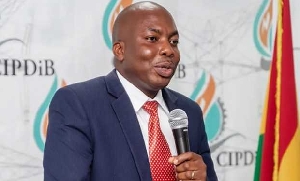- Home - News
- TWI News | TV
- Polls
- Year In Review
- News Archive
- Crime & Punishment
- Politics
- Regional
- Editorial
- Health
- Ghanaians Abroad
- Tabloid
- Africa
- Religion
- Election 2020
- Coronavirus
- News Videos | TV
- Photo Archives
- News Headlines
- Press Release
Business News of Tuesday, 25 June 2013
Source: B&FT
Prospects amid weaknesses in banking industry
Low financial intermediation in Ghana, where only 6 percent of adults accessed a loan in the past year, points to significant growth prospects in retail and SME banking over the medium-term, Moody’s Investor Service, the ratings agency, has said in a new report.
In addition, the country’s medium-term growth prospects, political stability, commercialisation of oil and gas resources as well as rising foreign direct investment “suggest an accommodative environment for banks that will facilitate growth and loan syndications in the oil and gas, cocoa and telecom sectors,” the report, authored by Constantinos Kypreos, Moody’s Vice President and Senior Credit Officer, stated.
This potential will however take time to fully unlock due to a number of weaknesses, said Mr. Kypreos, including a lack of consumer information and the limited use of credit bureaux. The dominance of traditional branch networks will also derail efforts to expand banking services into rural areas. World Bank financial inclusion data reveal that less than a third (29 percent) of adults in Ghana have an account with a formal financial institution, with five times fewer adults accessing a loan in the past year.
Despite the Bank of Ghana’s (BoG) introduction of a formal credit-reporting regime in 2007-08 through the passage of a law and the licencing of the country’s first credit bureau, some limitations have been identified in the credit reporting environment -- including some banks’ reluctance to fully disclose information on clients to assist credit appraisal.
Writing in the B&FT last week, Managing Director of The Royal Bank, Robert Bentil, said there is a need for increased education on credit reporting as it remains a critical element for improving access to, and the cost of, credit.
Moody’s commended the shift by the BoG from a compliance-based to a risk-based system of supervision, and the regulator’s tightened focus on strengthening banks’ risk-management capacity.
It, however, echoed concerns also expressed by the International Monetary Fund (IMF) over the governance and regulatory problems posed by high direct and indirect Government ownership of banks, including the “conflict of interest” inherent in the BoG’s shareholding in some banks.
The state’s significant involvement “raises corporate-governance issues, creating conflicts over development decisions and has been one of the main reasons behind the system’s high non-performing loan (NPL) levels,” said Mr. Kypreos.
NPL ratios were second-highest in Ghana among six markets covered by the report, with Ghana’s 13.2 percent ratio more than 3 times the level in Nigeria.
The IMF recently called for higher minimum capital buffers in the Ghanaian banking industry to contain vulnerabilities, including the risk of increasing nonperforming loans. NPLs peaked at a high of 20 percent in February 2010 before declining gradually to 13.2 percent in 2012.
In December, the BoG concluded the second stage of the industry’s recapitalisation, which raised the minimum capital requirement from GH¢25million to GH¢6million.
An analysis by the B&FT of all but two banks in the industry showed that a 25 percent boost to current minimum capital requirements would mean 12 of the players must inject combined additional capital of almost GH¢140million into their operations.
In terms of profitability, Moody’s report showed that Ghanaian banks have the third-best Return on Assets (RoA) and second-best Return on Equity (RoE) among the six markets, which also included Angola, Kenya, Zambia and Senegal.
The industry RoA was 3.3 percent in Ghana, compared to 1.2 percent in Nigeria; 1.6 percent in Angola; 3.7 percent in Kenya; 3.9 percent in Zambia; and 1.8 percent in Senegal. RoE ratios were 22.4 percent in Ghana, 8.9 percent in Nigeria, 12.5 percent in Angola, 29.7 percent in Kenya, 20.8 percent in Zambia, and 17 percent in Senegal.










